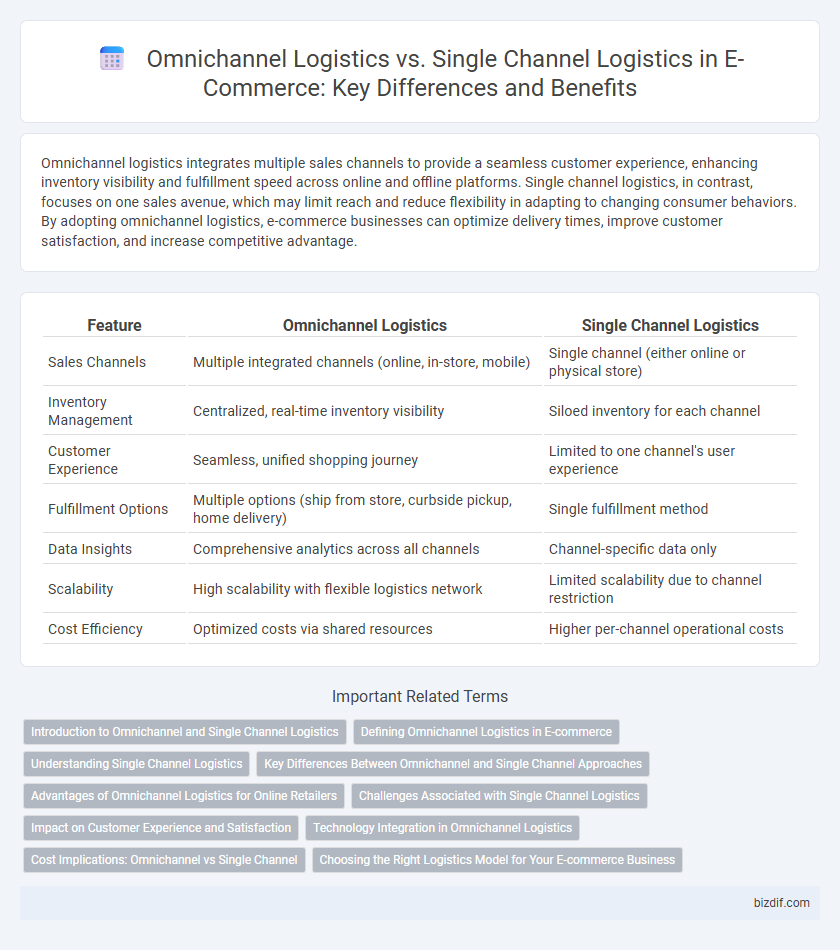Omnichannel logistics integrates multiple sales channels to provide a seamless customer experience, enhancing inventory visibility and fulfillment speed across online and offline platforms. Single channel logistics, in contrast, focuses on one sales avenue, which may limit reach and reduce flexibility in adapting to changing consumer behaviors. By adopting omnichannel logistics, e-commerce businesses can optimize delivery times, improve customer satisfaction, and increase competitive advantage.
Table of Comparison
| Feature | Omnichannel Logistics | Single Channel Logistics |
|---|---|---|
| Sales Channels | Multiple integrated channels (online, in-store, mobile) | Single channel (either online or physical store) |
| Inventory Management | Centralized, real-time inventory visibility | Siloed inventory for each channel |
| Customer Experience | Seamless, unified shopping journey | Limited to one channel's user experience |
| Fulfillment Options | Multiple options (ship from store, curbside pickup, home delivery) | Single fulfillment method |
| Data Insights | Comprehensive analytics across all channels | Channel-specific data only |
| Scalability | High scalability with flexible logistics network | Limited scalability due to channel restriction |
| Cost Efficiency | Optimized costs via shared resources | Higher per-channel operational costs |
Introduction to Omnichannel and Single Channel Logistics
Omnichannel logistics integrates multiple sales channels, including online stores, physical outlets, and mobile platforms, to provide seamless customer experiences and flexible delivery options. Single channel logistics focuses on managing inventory and deliveries through one primary sales channel, typically either online or brick-and-mortar, resulting in more straightforward but less versatile supply chain operations. The shift toward omnichannel logistics reflects growing consumer demand for convenience, real-time inventory visibility, and faster fulfillment across all touchpoints.
Defining Omnichannel Logistics in E-commerce
Omnichannel logistics in e-commerce integrates multiple sales and distribution channels to provide a seamless customer experience across online stores, physical retail locations, and third-party marketplaces. This approach optimizes inventory management, order fulfillment, and delivery by leveraging real-time data synchronization and cross-channel visibility. Businesses adopting omnichannel logistics achieve higher customer satisfaction through faster delivery times and flexible fulfillment options like buy-online-pickup-in-store (BOPIS) and ship-from-store.
Understanding Single Channel Logistics
Single channel logistics refers to the management of inventory, order fulfillment, and delivery through a single sales channel, often limiting reach to only one customer touchpoint such as a physical store or an online platform. This approach simplifies supply chain operations but can restrict scalability and customer experience compared to omnichannel logistics. Efficient single channel logistics demands precise inventory control, streamlined warehousing, and optimized last-mile delivery within the focused channel.
Key Differences Between Omnichannel and Single Channel Approaches
Omnichannel logistics integrates multiple sales channels, providing seamless inventory management and consistent customer experiences across online, in-store, and mobile platforms, while single channel logistics focuses on optimizing supply chain operations for a single sales outlet. Inventory visibility and order fulfillment are enhanced in omnichannel logistics through real-time data synchronization, which reduces stockouts and enables flexible shipping options like buy online pickup in store (BOPIS). In contrast, single channel logistics typically experiences limited customer touchpoints and less complexity in distribution, often resulting in slower response to demand fluctuations and fewer delivery options.
Advantages of Omnichannel Logistics for Online Retailers
Omnichannel logistics enhances inventory management by synchronizing stock across multiple sales channels, reducing stockouts and overstock situations. It improves customer satisfaction through faster, flexible delivery options like buy online, pick up in-store (BOPIS), and seamless returns. This approach also increases operational efficiency by integrating order fulfillment processes, leading to higher sales conversion rates and better data-driven decision-making for online retailers.
Challenges Associated with Single Channel Logistics
Single channel logistics often faces significant challenges such as limited customer reach and inefficient inventory management, leading to slower delivery times and increased operational costs. The lack of integration across multiple sales platforms restricts data visibility, causing poor demand forecasting and stockouts. This approach struggles to meet evolving consumer expectations for seamless shopping experiences, ultimately impacting customer satisfaction and retention.
Impact on Customer Experience and Satisfaction
Omnichannel logistics enhances customer experience by providing seamless, flexible purchasing and delivery options across multiple platforms, improving convenience and satisfaction. Single channel logistics limits customer touchpoints to one platform, often causing delays and reduced service quality. Integrating omnichannel logistics strategies can significantly increase customer retention and positive reviews by meeting modern consumers' expectations for speed and accessibility.
Technology Integration in Omnichannel Logistics
Omnichannel logistics leverages advanced technology integration such as real-time inventory management, AI-driven demand forecasting, and automated order fulfillment systems to create a seamless customer experience across multiple sales channels. Single channel logistics often relies on more isolated, less integrated systems that limit visibility and efficiency. The integration of technologies in omnichannel logistics enhances supply chain agility, reduces delivery times, and improves inventory accuracy across online, offline, and mobile platforms.
Cost Implications: Omnichannel vs Single Channel
Omnichannel logistics often incur higher upfront costs due to the complexity of managing multiple sales channels and distribution points, but they enable cost savings through inventory optimization and improved customer reach. Single channel logistics typically have lower initial expenses but risk higher long-term costs from limited market exposure and inefficient stock utilization. Investing in omnichannel solutions can reduce returns and increase customer satisfaction, ultimately driving greater revenue despite the higher operational expenditure.
Choosing the Right Logistics Model for Your E-commerce Business
Omnichannel logistics integrates multiple sales channels, providing seamless inventory management and real-time order fulfillment, which enhances customer experience and drives sales growth. Single channel logistics focuses on one sales platform, offering simplified operations but limiting market reach and scalability. Selecting the right logistics model depends on your e-commerce business size, target customer base, and long-term growth strategy to balance efficiency and customer satisfaction.
Omnichannel Logistics vs Single Channel Logistics Infographic

 bizdif.com
bizdif.com